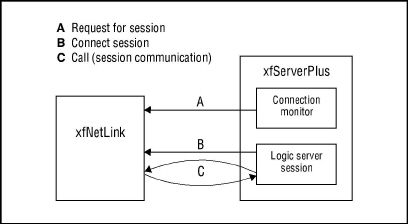Complete a debug connection to xfServerPlus
|
WSupported on Windows
|
USupported on Unix
|
VSupported on OpenVMS
|
|
status = %RX_DEBUG_START(netid, [trace_flag], [trace_file], [call_timeout], & [sess_timeout], [secure_status] [, scl])
Return value
status
Indicates whether the request for a remote session was successful. (n)
The status codes returned are the same as for %RX_START_REMOTE. See the %RX_START_REMOTE Status Codes table.
Arguments
netid
Network connection ID describing the connection to the machine on which remote routines are executed. You should pass the net ID returned by the corresponding %RX_DEBUG_INIT routine. (n)
If you call %RX_DEBUG_START and pass a net ID that was not returned by %RX_DEBUG_INIT, the runtime error $ERR_XFNOINIT is signaled.
If the net ID is invalid, $ERR_NOTNETHND or $ERR_INVNETHND is signaled. See the Synergy Runtime Errors Signaled by %RXSUBR table for explanations of these codes.
trace_flag
(optional) Indicator that client packets should be logged. The default is false. (n)
trace_file
(optional) The file the packets should be logged in. (a)
If a filename is passed, it is used. Otherwise, synergy.ini (or the corresponding environment variable on Unix) is checked for the value XFNLS_LOGFILE. If no file is found, the packets are displayed on the screen of the client machine.
call_timeout
(optional) The length of time (in seconds) that the remote session request should wait for the results of a remote routine call. The default is 1800 seconds (30 minutes). (n)
This time-out is measured for each send–receive request between xfNetLink and xfServerPlus. (This is ‘C’ in figure 1.)
If a call time-out is passed, it is used. Otherwise, synergy.ini (or the corresponding environment variable on Unix) is checked for the value XF_RMT_TIMOUT. If no time-out is specified there or if the value is ≤ 0, the default is used. This value is associated with the network connection ID and may be changed at runtime with %RX_RMT_TIMOUT.
|
|
For more information on setting time-outs for xfNetLink Synergy, see Specifying time-out values. |
sess_timeout
(optional) The length of time (in seconds) that the remote session request should wait for a session connection from xfServerPlus. The default is 600 seconds (10 minutes). (n)
This time-out is measured from the time that xfNetLink receives the connection request acknowledgment from the connection monitor to the time it receives an acknowledgment from the session started by the logic server. (This is ‘B’ in figure 1.) Note that the time-out for the request for session from the connection monitor is 2 minutes (‘A’ in figure 1): if no acknowledgment is received from the connection monitor within 2 minutes, a time-out will occur no matter how sess_timeout is set.
If a session time-out is passed, it is used. Otherwise, synergy.ini (or the corresponding environment variable on Unix) is checked for the value XF_RMT_DBG_TIMOUT. If no time-out is specified there or if the value is ≤ 0, the default time-out is used.
|
|
secure_status
(optional) Returns the encryption status of the server machine. (n)
0 = Encryption not enabled
1 = (deprecated in Synergy/DE 11; previously indicated slave encryption)
2 = Encryption is enabled
scl
(optional) The security compliance level. Indicates the available protocols to use for encrypted data. (n)
0 = Always use the current Synergy default
1 = (No longer valid; removed in Synergy/DE 11.1 )
2 = Use protocols TLS 1.1, TLS 1.2, and higher
3 = Use protocols TLS 1.2 and higher (default)
4 = Use protocols TLS 1.3 and higher
Discussion
%RX_DEBUG_START completes the process of connecting in debug mode that was started by %RX_DEBUG_INIT. After the listening port and IP have been displayed, use this function to complete the connection so that you can start a debug session. This function is used only for Windows and Unix servers—not for OpenVMS.
See Running in debug mode on Windows and Unix for more information.

